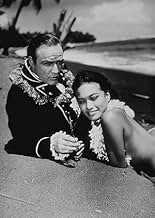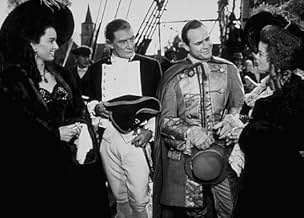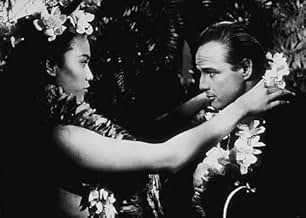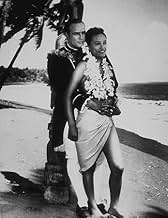En 1787, le navire britannique Bounty quitte Portsmouth pour apporter une cargaison de fruits à pain de Tahiti, mais les conditions de bord brutales déclenchent une mutinerie menée par l'off... Tout lireEn 1787, le navire britannique Bounty quitte Portsmouth pour apporter une cargaison de fruits à pain de Tahiti, mais les conditions de bord brutales déclenchent une mutinerie menée par l'officier Fletcher Christian.En 1787, le navire britannique Bounty quitte Portsmouth pour apporter une cargaison de fruits à pain de Tahiti, mais les conditions de bord brutales déclenchent une mutinerie menée par l'officier Fletcher Christian.
- Réalisation
- Scénario
- Casting principal
- Nommé pour 7 Oscars
- 3 victoires et 13 nominations au total
Avis à la une
This is the second adaptation of the vintage story of mutiny during the turbulent voyage based on one of history's greatest true life sea adventure . It's the colorful classic version very well played and with marvelous scenarios . Interesting screenplay tough there are some gaps and flaws , as many writers did uncredited rewrites on the script, including Eric Ambler, William L. Driscoll, Borden Chase, John Gay and Ben Hecht . Big budget adaptation as the film cost an estimated $19 million in 1962 which was a huge expenditure at the time . The ship cost $750,000 to reconstruct ; for almost four decades, the ship used in this film, has been a popular tourist attraction in St. Petersburg, Florida. Visitors get to tour the ship itself and learn more about both the historical H.M.S. Bounty and MGM's two screen versions of the Nordhoff and Hall book . She was reused in ¨Caribbean pirates¨ and was also used in ¨Treasure island ¨ and sank during Hurricane Sandy in 2012.
This account of the mutiny led by Fletcher Christian against captain Bligh is highlighted thanks to glamorous cinematography by Robert Surtees , as the last Ultra Panavision film to be shown in the extremely wide screen. Emotive as well as haunting musical score by Bronislau Kaper . Extremely memorable acting by Marlon Brando who brings his own powerful individualism to contrasting role of Trevor Howard with opposing attitude whose inevitable clash receives greatest importance . Interesting portrayal of Fletcher Christian's Marlon Brando and Bligh's Trevor Howard who bears little relation to Mel Gibson-Anthony Hopkins version . Furthermore , a sensual and romantic relationship between Marlon Brando and Tarita, the Tahitian beauty actress who played Maimiti, they met during filming and later married. Secondary cast is frankly excellent , such as Percy Herbert as Seaman Matthew , Duncan Lamont as John Williams , Gordon Jackson as Seaman Edward ,Noel Purcell a Seaman William , Eddie Byrne as John , Frank Silvera as Minarii and Hugh Griffith was fired during filming when his alcoholism became unmanageable , that is why his character disappears for large portions of the film . Compelling direction by Lewis Milestone who captures the feel of sea and harshness of the times . After the firing of Carol Reed, Marlon Brando began to usurp the power of replacement director Lewis Milestone , a well-respected veteran with two directing Oscars to his credit , in fact , it was last movie directed by Lewis Milestone ; he only did two TV episodes after this . Other renditions based on these historical events are the followings : Old and black and white take on titled 'Mutiny on the Bounty (1935)' by Frank LLoyd with Clark Gable , Charles Laughton and Franchot Tone and revisionist storytelling titled ¨Bounty¨ by Roger Donalson with Mel Gibson , Anthony Hopkins , Bernard Fox and Liam Neeson .
The real deeds are the following : In 1787, Captain Bligh was chose to command HMS Bounty on a voyage to Tahiti, where he was to collect breadfruit trees with the object of introducing them to the Caribbean . Ironically, the breadfruit seedlings which Bligh brought to Jamaica as an inexpensive food for the slaves working on English plantations were an utter failure , as the slaves took one bite, and refused to eat any more . Captain Bligh is determined to reach Tahiti and return with a hold full of breadfruit trees. When the ship sailed after a six-month stay on the island, Bligh's men mutinied , casting him and a handful of loyal crew members adrift with scant provisions and no chart. Bligh's incredible seamanship brought them safely to Timor after a voyage of 4000 miles. Fletcher Christian and the other mutineers sailed on to the island of Pitcairn. The mutineers' fate remained in mystery for 18 years until their island was discovered by an American whaling ship , they found one man , John Adams, with nine women and 23 children. What happened Fletcher Christian remains uncertain, some say he was murdered on Pitcairn island, but then there were reports that he returned safely to England . However the descendants live on Pitcairn island to this day.
Howard's Bligh is brilliant, and not at all like the prancing cartoonish Charles Laughton version in '35. And when it comes to Christian, the protaganist of the mutiny, Brando makes an admirable effort to capture the essence of the the fopish and aristocratic character as portrayed in the Nordhoff and Hall book upon which both MGM "Bountys" are based. Brando becomes Christian, in the 1935 movie Clark Gable as Christian is just Gable as Gable, and that's that. Richard Harris as crew member Mills, is another solid portrayal in the 1962 movie.
Don't get me wrong, the 1935 movie's fun, but the 1962 movie is infinitely more impressive in all respects, especially its use of a real ship made just for the film, the awesome "shots" of life at see in the late 1700s, and of course the spectacular location filming in Tahiti.
1935's Mutiny on the Bounty, was a fine film in its day, but it doesn't stand the test of time, 1962's film stands that test. Is it a great movie, probably not, but it is a very good one. Considering that MGM did not deliver the ship on time for filming before the bad weather set in in Tahiti, MGM's firing of legendary director Carol Reed, and other miscalculations mainly attributable to producer Aaron Rosenberg, the film is a remarkable achievement.
The studio used an off-form Lewis Milestone as a replacement for director Reed. Once they decided that Reed wasn't their cup of tea, they just tried to slide by with Milestone, instead of securing the services of one of the many still vital directing greats working in the early 1960s. A movie of epic proportions like 1962's Mutiny on the Bounty, cried out for a William Wyler, a David Lean, or a Fred Zinneman, to take over the helm once Reed was canned.
When the movie didn't hit like gangbusters, MGM's publicity machine moved quickly to "sandbag" their star, and the lemmings of the early 60s entertainment press corps swallowed the studio's propaganda whole. It was open-season on Brando, and it was shameful, but anybody who has seen the movie and also read the book, knows that Brando's Christian is a very solid performance. I'm sure Brando was peevish and nettlesome at times during production, Trevor Howard says as much in his biography, but to blame Brando for the film's bloated final cost and its lack of epic earnings is ludicrous.
I love 1962's Mutiny on the Bounty, it should have been better, but its still one beautiful movie. It is an under-appreciated and highly underrated movie. I strongly recommend it, to me calling Brando and Howard's Mutiny on the Bounty of 1962, a minor film, as one IMDb movie fan recently did, is blasphemous. The truth is MGM, just fumbled the ball on Mutiny on the Bounty in 1962, despite all of their ineptitude during production, they still had what should have been a major hit. But they opened it as a road-show movie in just a few theatres nation wide instead of in as many theatres as possible like the studios do with all major movies today. Despite MGM's poor efforts 41-years ago, movie fans today can scoop up the old lion's fumble and enjoy this exciting high seas adventure/love story.
It took a better book, Richard Hough's "Mr. Bligh and Mr. Christian," to produce a better movie rendition of the true life Mutiny on the Bounty. That book was the basis for the magnificent, "The Bounty," starring Anthony Hopkins as Bligh, and Mel Gibson as Christian. Also adding lustre to that movie were Liam Neeson, and Daniel Day-Lewis.
When I many years later decided to buy it on VHS and watch it concentratedly, I fell in love with it immediately. I have always been a fan of large-scale films like Ben Hur, Doctor Zhivago and Lawrence of Arabia and Mutiny is definitely a "large-scale" film. Not only boasting a wide variety of colourful locations, from breathtaking, sun-drenched sea vistas to exotic beachscapes on Tahiti, it also includes some great actors, such as Marlon Brando, Richard Harris and Trevor Howard as the despicable captain Bligh. Contributing to the "large-scale" feel is Bronislau Kaper's lush and magic music score, featuring haunting chorus statements of the main theme, interestingly entitled "Follow me". The music was so lovely that I had to try out the theme on the piano once I finished watching the film.
I suppose most readers of this post are already familiar with the basic plotline, so I will not have to go through that.
I find that the film contains quite a lot of nice dialogue that sticks in your memory. But it is above all the growing conflict aboard the ship that is the major interesting theme of the film. Just to see how the conflict between Bligh and Christian builds step by step, from more or less nothing to mutiny. Even though it is unpleasant, it is a delight to follow. In any case, it had me glued to the screen.
I cannot say whether the events are portrayed authentically as they happened historically or not, but to me that is of minor interest. The film comes out magnificent all the same and appear to me to be quite realistic.
Another thing about the film that appealed to me is that it is so beautiful. Not only are the locations beautiful, but a lot of the actors, their contemporary clothing, not to mention the Tahitian beauties, are simply eye-catching. The Bounty, the ship itself, is also quite something else. A lot of the film's beauty, I believe, also has to do with good photography thoughout. The film lends itself incredibly well to widescreen-viewing.
I would heartily recommend this film to any fan of cinema. It is a film filled to the brim with colour and spectacle with marvelous actors and a catching and disturbing story of power abuse and the British Empire in its heyday. The only disturbing thing at the moment of writing, is that it still has not been released on DVD. But when it is, I sincerely hope it comes in a deservedly magnificent picture- and sound-transfer including a mountain of extras. I simply cannot wait.
It's fair to say you are a Captain disciplined, and you like to see subordinates lose skin, the cat o' nine tails is a smash, as they're beaten, whipped and slashed, filling your sails with such an overwhelming wind. If all else fails you go the distance and keelhaul, dragging the guilty of just what on a long trawl, prevents the crew from going soft, like rotten food they have to scoff, although you never hear the sounds, of their death squall. Although this time it seems you've pushed the boat too far, Fletcher Christian takes his chance to fight and spar, your ejected and cast-off, mutinous rabble will pay the cost, as you're left to drift for weeks, under the stars.
Brando's accent - what's that all about.
Le saviez-vous
- AnecdotesThe ship built for the film sank in the Atlantic Ocean after taking on water on October 29, 2012 during Hurricane Sandy off of the East Coast of the United States. It was last seen with only the masts standing above the water. Two of the crew died: the Captain, Robin Walbridge, and Claudene Christian, the direct descendant of Fletcher Christian.
- GaffesThe actual mutiny did not happen in the manner portrayed in the film. Christian and the other mutineers actually took the ship in the early hours of the morning, while Bligh and almost everyone else was asleep.
- Citations
Fletcher Christian: [to Captain Bligh] You remarkable pig. You can thank whatever pig god you pray to that you haven't turned me into a murderer.
- Versions alternativesThe original 1962 print had a different opening scene, in which a ship's crew lands on Pitcairn and discovers an artifact belonging to the H.M.S. Bounty. They can barely read the name until William Brown (Richard Haydn), now aged, appears on the beach and says "Bounty". He then proceeds to tell the story of the famous mutiny, of which he is apparently the last surviving member. That is why we hear his voice narrating the story. In all current prints, including the one shown on Turner Classic Movies ca. 2005, this opening scene is omitted, so we do not know why Brown is telling the story in voiceover. However, the scene has been restored on the 2006 DVD release.
- ConnexionsFeatured in Hollywood: The Fabulous Era (1962)
Meilleurs choix
Détails
- Date de sortie
- Pays d’origine
- Langues
- Aussi connu sous le nom de
- Motín a bordo
- Lieux de tournage
- Bora Bora, Leeward Islands, Polynésie Française(first breadfruit collecting party)
- Société de production
- Voir plus de crédits d'entreprise sur IMDbPro
Box-office
- Budget
- 19 000 000 $US (estimé)
- Durée2 heures 58 minutes
- Rapport de forme
- 2.76 : 1
Contribuer à cette page




































